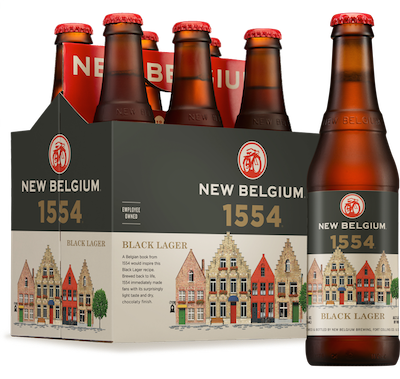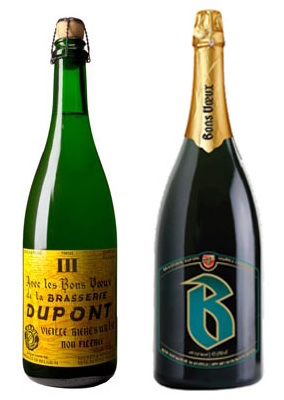As craft beer consumers, we rely on labels to operate according to a couple of standards—namely, style guidelines and commonly accepted signifiers. Whether it’s “IPA,” “porter,” or the more esoteric and ephemeral “brett beer” or “imperial red ale,” we draw on our years of tasting, analyzing, and figuring out exactly what these beers are in the grand context of the industry.
Sometimes, though—for better or for worse—we don’t get what we expect. I doubt these breweries are actively trying to fool anyone, and these are all great beers; just make sure you read the fine print, or that first sip might surprise you.
1. Ballast Point Pale Ale
San Diego, Calif.
5.2% ABV
You could be forgiven for assuming that Ballast Point Pale Ale is, well, what it says on the label: a pale ale. No kitschy nautical terms here, just the name of the beer style, and the name of the brewery that made it. If you neglected to do your homework, however, you might be at least underwhelmed when you take your first sip, expecting a piney, citrusy hop bouquet, and are instead greeted by a much more subdued, lager-type flavor profile. Like the good Freshness Nazi you are, you start checking “best by” dates, while mentally composing your letter of complaint.
Slow your roll, neckbeard. What you’re tasting is a kolsch, and it’s one of the better American-made examples. A light-bodied, well-attenuated beer, it is fermented with ale yeast but conditioned like a lager. It should be crisp and dry, with a mild, floral hop bouquet and maybe a hint of white wine. Trust me: on a hot summer day you can’t do much better, and once you’ve accepted the notion that Ballast Point might just be executing some decades-long, laborious Rick Roll on its customers, you’ll make your peace with this great beer.
2. New Belgium 1554 (Enlightened Black Lager)
Fort Collins, Colo.
5.6% ABV
Forget about the extreme ends of New Belgium’s portfolio. Fat Tire and La Folie are great and all, but 1554 is hands-down the best, most consistent beer they make, and it’s been that way for a long time. But what about that name? “Enlightened Black Lager.” It’s as descriptive as it is uninformative, and adds mystique to a simple yet beguiling beer.
So we’re repaying the talented brew team at New Belgium by taking a data-shaped bludgeon to that mystique. 1554 actually falls into a fairly broad style of dark, off-sweet lagers—dunkel or tmavý—brewed with equal aplomb by German and Czech producers. This particular example is rich for the ABV, with strong dark chocolate and nutty flavors, but other iterations range from earthy and spicy to oaky, with hints of vanilla or almond.
3. Hofstettner Granitbock
St. Martin, Austria
7.3% ABV
Plug the official Rate Beer description for this thing into Google Translate, and what you get reads like a fan-written “Zardoz” spinoff featuring only goats and rocks. Somewhat counter-intuitively, the Hofstettner Granitbock is in many places referred to as a “doppelbock;” if you’ve made it this far into the article, you’ll know that that’s a severe understatement of reality.
It’s true that the Granitbock is a strong, dark, bottom-fermented lager, all hallmarks of the doppelbock style. However, the wort—essentially, un-fermented beer—is brought to boil by tossing super-heated granite stones into the vat, raising the temperature and caramelizing the malts therein. As a result, sweet, smoky notes underscore and complement the rich, toffee-like malt characters of the beer, distinguishing it in a big way from other examples of the style. Beers that utilize this process are also known as “stein beers,” and a great American example can be found in Port Brewing’s Hot Rocks Lager.
4. Dupont Avec Les Bons Voeux
Tourpe-Leuze, Belgium
9.5% ABV
The categorical history of this beer is a bizarre one, and that alone merits its inclusion in this list. At one time ranked among the top saisons in the world—and still is, in certain circles—it has since been re-categorized, mostly because of its comparatively high alcohol content, as an abbey tripel. If you’ve got some time on your hands, there’s a pretty involved Rate Beer thread debating this issue, and each camp makes some valid points.
Consider this: current brewmaster Olivier Dedeycker has on certain occasions referred to Avec Les Bonx Voeux and Moinette—another strong Dupont product, brewed with honey—as “super saisons,” though he uses the term reluctantly; on others, he has utterly dismissed the term. It’s easy to see why: saisons were initially brewed for farm workers as refreshment, and were generally not much above 4% abv. Dedeycker is supremely aware of that, yet is still comfortable classifying his 6.5% abv product as a saison.
All well and good, but what does the damn thing actually taste like? To my palate, like a particularly rich saison: spicy and mildly phenolic (at least when young), with some big floral hops and a hint of honey. The malt bill still renders ALBV a golden beer, but it is hefty, and feels heavier on the palate than a standard saison.
If that sounds like a pronouncement, it is—but only my own. Tasting notes of this beer run the gamut, hence its inclusion here.
5. Oxbow Blended Oxtoberfest
Newcastle, Maine
6.5% ABV
Even in my limited experience with Oxbow, I can tell that the minds behind the operations aspect of the brewery are…playful. More than anything, Oxbow exhibits a sort of Janus-like tendency: to profess one thing, to be another, to somehow be completely honest in both regards. The main brewery is still ensconced out in the woods of rural Maine, yet they have a tasting room in the middle of Portland proper; the entrance looks like the outside of that body-mod leather bar from “Orphan Black,” but the inside is all rich mahogany-meets-airplane-hangar.
And then there’s…this. This beer. Oxbow has to know that they’re taking the piss with that name, as this rustic, funky beast is anything but a marzen-style lager. The brewers categorize the base beer as a “farmhouse festbier,” but that’s not even technically a thing. It’s kind of like saying “Slovenian mullet;” everyone kind of knows what you mean, but they also have no idea. For what it’s worth, that base beer is indeed somewhat nutty and caramelly, but also minerally, a tad funky, with a hard-to-pin-down spice character.
Anyway. Blended Oxtoberfest is a mixture of fresh Oxtoberfest (see above, if that helps in the slightest) and a barrel-aged version. The one I tasted had been blended with beer that spent twelve months in riesling wine barrels with a mixed brettanomyces culture and lactobacillus. And yes, it is insanely good: bitingly citric up front, with a hint of marzipan, oak, earthy hops, and a creamy mouthfeel despite the effervescence. It is utterly unique, and nothing like what you’d be led to believe.




